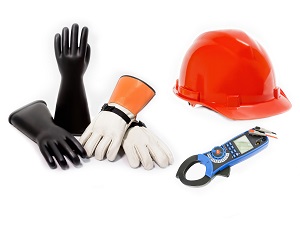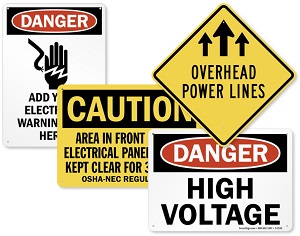Working near electrical hazards can be dangerous, and even fatal. Any work activities performed on or near energized equipment must be done only when safety measures are in place to provide protection to workers.

Electrical Hazards
Electricity hazards can cause dangerous and fatal incidents like:
- Electric Shock
- Electrocution
- Burns
- Fires
- Explosions
Electricity can also result in indirect injuries from falls caused by electric shock, like abrasions, puncture wounds, broken bones or concussion.
OSHA Construction Standard 1926.416(a)(1) No employer shall permit an employee to work in such proximity to any part of an electric power circuit that the employee could contact the electric power circuit in the course of work, unless the employee is protected against electric shock by deenergizing the circuit and grounding it or by guarding it effectively by insulation or other means.
Most electrical incidents result from one of these three factors:
- unsafe equipment or installation
- unsafe environment
- unsafe work practices

The following hazards are the most frequent causes of electrical injuries:
- path to ground missing or discontinuous
- lack of ground-fault protection
- contact with power lines
- improper use of equipment, extension cords, or other flexible cords
Electrical Safety Practices
OSHA General Industry Standard 1910.333(a) Safety-related work practices shall be employed to prevent electric shock or other injuries resulting from either direct or indirect electrical contacts, when work is performed near or on equipment or circuits which are or may be energized. The specific safety-related work practices shall be consistent with the nature and extent of the associated electrical hazards.
Never bypass any protective system or device that is designed to protect employees from contact with electrical energy. If electrical equipment is used in ways for which it is not designed, you can no longer depend on safety features built in by the manufacturer.

The normal wear and tear on extension and flexible cords at your site can loosen or expose wires, creating hazardous conditions. Flexible cords that are not 3-wire type, not designed for hard-usage, or that have been modified, increase risk of contacting electrical current.
OSHA Construction Standard 1926.403(b)(1) The employer shall ensure that electrical equipment is free from recognized hazards that are likely to cause death or serious physical harm to employees.
All workers must be aware of the electrical hazards to which they are exposed, follow safe electrical work practices, and should:
- be trained in electrical safety for the work they will be doing.
- ensure machinery and power tools are properly grounded or double insulated.
- check all extension and power cords for wear and tear before use.
- disconnect the plug on any power tool or machinery before inspecting or repairing.
- stay at least 10 feet from live overhead power lines.
- keep metal objects away from live electrical circuits/parts.

Properly maintained tools and equipment help protect workers against electrical hazards. Inspect electrical tools and equipment before each use. If you find a defect, immediately remove it from service and tag it so no one will use it until it has been repaired or replaced. Only use tools and equipment according to the manufacturer’s instructions.
OSHA General Industry Standard 1910.333(a)(1) Live parts to which an employee may be exposed shall be deenergized before the employee works on or near them, unless the employer can demonstrate that deenergizing introduces additional or increased hazards or is infeasible due to equipment design or operational limitations.
Workers who perform electrical repairs must be trained, qualified, and should:
- de-energize and lock out or tag out electrical circuits/parts they will be working on or near.
- work only on live electrical circuits/parts in accordance with a permit system with specific procedures and only if they are qualified to do so.
- use appropriate personal protective equipment (PPE), such rubber insulating gloves, hoods, sleeves, matting, blankets, line hose, and industrial protective helmets.
- use proper tools when de-energizing or testing live electrical circuits/parts or otherwise working live.
- never work on energized equipment that is faulty or damaged.
- protect themselves against all electrical hazards including shock, arc flash, burns and explosions.
OSHA Construction Standard 1926.417(b) Equipment or circuits that are deenergized shall be rendered inoperative and shall have tags attached at all points where such equipment or circuits can be energized.
A variety of possible solutions may be implemented to reduce or eliminate the risk of injury associated with electrical work, including the use of insulation, guarding, grounding, electrical protective devices, and safe work practices.

When using a tool to handle energized conductors, check to make sure it is designed and constructed to withstand the voltages and stresses to which it has been exposed.
Visually inspect all electrical equipment before use. Take any defective equipment out of service.
OSHA General Industry Standard 1910.334(a)(2)(ii) If there is a defect or evidence of damage that might expose an employee to injury, the defective or damaged item shall be removed from service, and no employee may use it until repairs and tests necessary to render the equipment safe have been made.
Before connecting electrical equipment to a power source, it’s a good idea to check the insulation for any exposed wires for possible defects. Insulation covering flexible cords such as extension cords is particularly vulnerable to damage. Effective guarding should be in place around equipment with exposed parts operating at 50 volts or more.
Hazard warning signs that are clearly worded and easily visible must be posted at the entrance to electrical rooms and similarly guarded locations to alert workers and forbid entry to unauthorized people.
Frequently inspect electrical systems to ensure that the path to ground is continuous. Ensure ground-fault circuit interrupters (GFCIs) are used in wet, damp, or high-risk work locations. Do not remove ground prongs from cord- and plug-connected equipment or extension cords.

.jpg)

